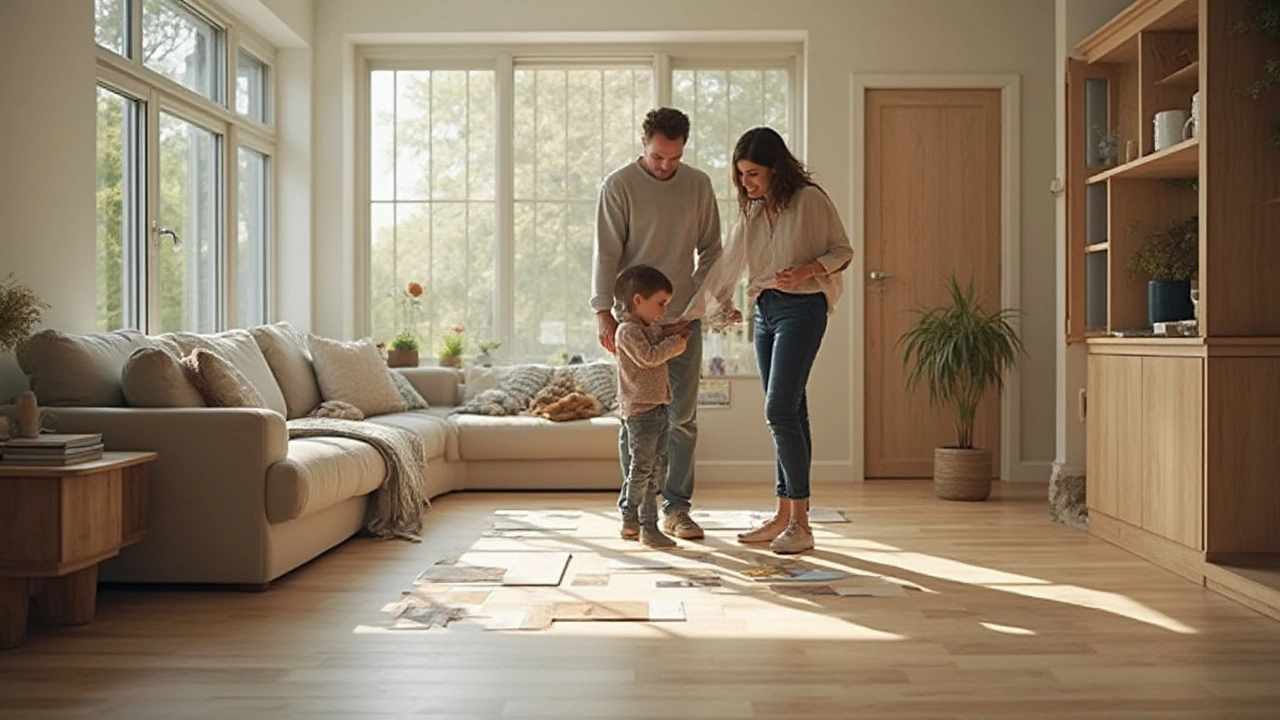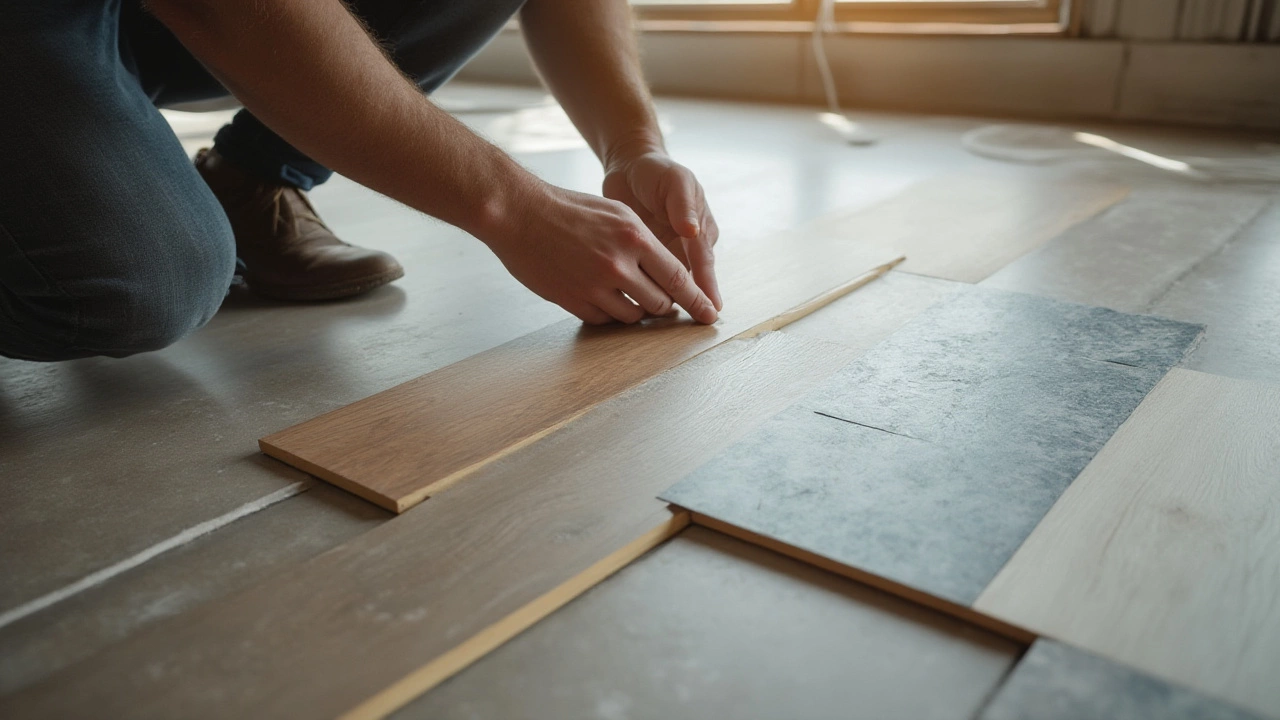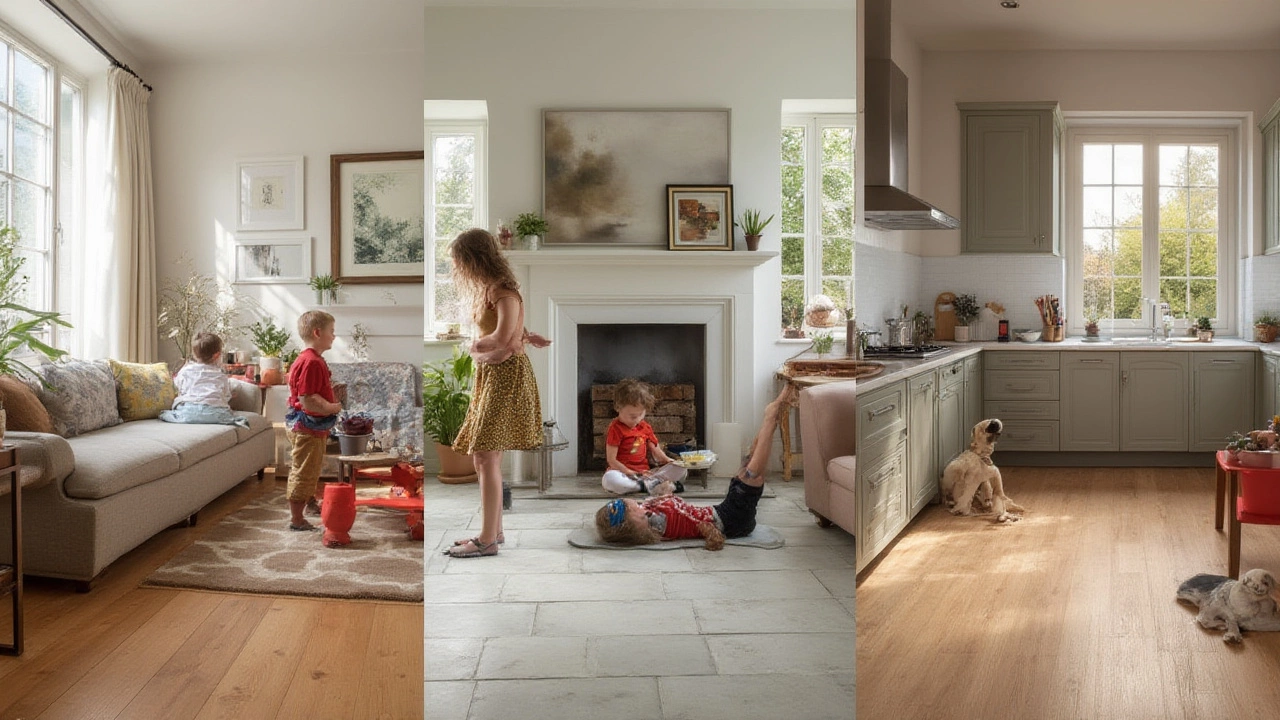Best Flooring for New Builds: Durable & Stylish Options for Your Dream Home
 Jul, 15 2025
Jul, 15 2025
Picking out flooring for a new build isn’t just another box to tick on the construction list—it’s the one thing you’ll walk on, drop coffee on, and maybe even teach your kid to dance on. Floors take a beating. They’re the foundation of your home’s look and feel. Bad call? Regret daily. Smart choice? Enjoy for decades without a second thought. So what’s actually the best flooring for your new place? It depends on how you live, what you love, and what you want your place to say about you.
How Lifestyle Shapes Your Flooring Choice
Imagine for a sec: two friends, both building new houses. One is a gym instructor with four dogs, the other is a tech worker living solo. Should they even look at the same floors? Definitely not. High-traffic spaces (think kids and pets racing through the living room) demand something tough. If you’re more Netflix than neighborhood hangout, you might lean style over bulletproof durability.
Kitchens and entryways take the brunt. Muddy shoes, spills, and dropped kitchen gadgets are regulars here. Bedrooms? Usually a safe zone, so you can go soft and cozy. The key is mapping the mess and then matching flooring to each area’s beatdown level—and your own tolerance for cleaning and maintenance.
For allergy-prone folks, hard floors like tile, wood, or vinyl are a relief—no hidden dust. If warmth under foot is non-negotiable, think carpets or engineered wood. Got radiant floor heating in your plans? Certain choices play better with heat—stone and tile are champs for efficiency.
Pro tip: Before signing off, grab a few samples and “live” with them in different rooms. Spill stuff, walk in with wet boots, or let the dog do its thing. You’ll spot winners and losers quickly.
Breaking Down Popular Flooring Types: Pros, Cons & Costs
Flooring isn’t just wood versus tile. Here’s a look at what’s actually out there, along with what each gets right—and wrong. Let’s break it down:
- Hardwood: Classic and timeless, adds value, warm feel. But: scratches easier than you think, sensitive to water, and higher up-front cost. Think $8-16 per sq ft installed.
- Engineered Wood: Looks almost identical to solid wood but has a plywood base, which resists expanding and contracting. Less expensive ($6-12 per sq ft). Not always refinishable.
- Laminate: Budget-friendly ($3-7 per sq ft) and tough, but can sound hollow and doesn’t love moisture. Styles vary but cheap stuff looks...cheap. Middle- and upper-end look surprisingly real.
- Luxury Vinyl Plank (LVP): Modern favorite. Waterproof, super tough, easy to swap out. Prices hover around $5-10 per sq ft installed. Does well in basements and bathrooms.
- Tile (Porcelain or Ceramic): Long-lasting, tons of colors and patterns, waterproof. Cold underfoot unless you add radiant heat. Grout needs love—nobody likes scrubbing it. $7-15 per sq ft installed.
- Carpet: Cozy, kills noise, and feels great on bare feet. Catches dust and needs regular deep cleaning. Mid-grade carpet runs $4-8 per sq ft installed.
- Bamboo & Cork: Eco-friendly choices. Bamboo’s tough but can scratch; cork is gentle on joints and quiet but can fade in sun. Multi-room installs can get tricky.
Cost does matter, but so does thinking long-term. Tile can last a lifetime, hardwood too if maintained, while even top-end carpet wears down after a decade or so. And when it comes to resale, hardwood and tile help homes sell faster—curb appeal isn’t just for lawns.
| Flooring Type | Durability (Years) | Average Installed Cost (per sq ft) | Water Resistance |
|---|---|---|---|
| Hardwood | 25+ | $8-16 | Poor to Moderate |
| Engineered Wood | 20-40 | $6-12 | Moderate |
| Laminate | 15-25 | $3-7 | Good |
| Luxury Vinyl Plank | 15-25 | $5-10 | Excellent |
| Tile | 30+ | $7-15 | Excellent |
| Carpet | 5-15 | $4-8 | Poor |
| Bamboo | 15-25 | $5-9 | Poor to Good |
| Cork | 10-20 | $7-12 | Poor |

Latest Flooring Trends for New Builds
This isn’t your grandparent’s shag. The world of flooring is changing like crazy thanks to new tech and materials. You’ll see a lot of luxury vinyl flooring (LVP) in homes, and for good reason—it’s practically indestructible, waterproof, and comes in patterns that fool plenty of eyes. If you crave a hardwood look without the price or hassle, LVP is a go-to for modern builders. Even some high-end homes use it for busy areas.
Wide-plank wood floors are huge right now. They make rooms feel bigger and less busy, and the trend shows no sign of going away. Oak dominates, but hickory and maple are making a comeback, mostly in natural or muted finishes.
Polished concrete is showing up in fresh, minimalist builds—especially basements and ground floors. It’s durable, low-maintenance, and you can stain or tint it however you want. Throw down a killer area rug and you’ve got Instagram’s new favorite look.
If sustainability’s your thing, watch for cork and bamboo. They’re fast-growing and renewable, and newer versions handle dents and sunlight better than older ones. Some new homes even blend flooring types—tile or LVP for high-traffic and wet rooms, carpet or wood for warmth where you want it. The mixed-material look can break up big open layouts and give rooms their own vibe.
Don’t just follow trends, though. Think about what’s easy for you to keep clean, and what will survive the next five years of your life—not just what’s hot in design magazines.
Installation: DIY or Pro?
Ever tried laying flooring? Some say it’s like a massive, satisfying puzzle. Others end up on YouTube for hours, cursing at a wonky corner. Cost is a big deal: DIY can save thousands if you’ve got the chops, but pro installers often get the job done in a day—and that comes with warranties and fewer headaches. LVP and laminate are the easiest DIY routes; they click together and need few tools. Solid hardwood, tile, or anything that involves glue or nails? Worth calling in the specialists, unless you love a challenge (and risk a lumpy floor).
With pro jobs, check installers’ credentials and get every number in writing. Some brands only honor their warranty if factory-trained pros do the work. If you go the DIY route, rent the right gear (like heavy-duty cutters or spacers), and dedicate a weekend—trying to floor and live in the house at once is chaos.
Timing matters too. Don’t install wood floors until heat and AC are up and running. Otherwise, boards might swell or shrink as the house “settles.” Moisture wreaks havoc, so for basements or areas below grade, stick with tile or luxury vinyl. No matter what, stash some extra planks or tiles; you’ll thank yourself for easy fixes down the road.

Tips for Making Your Final Choice
You can drown in samples and Pinterest boards, but a few tips make picking the right floor way simpler:
- People first: Who’s living there, and how will the floors get used? Kids and pets? Go tougher.
- Zone your home: Use different materials in high-traffic, wet, or cozy spots. Bedrooms rarely need the same stuff as kitchens.
- Budget beyond buying: Factor in future cleaning, maintenance, and repairs—a cheap floor that needs yearly fixes adds up.
- Mix for personality: Worried about too many transitions? Use thresholds or design borders for a seamless, smart look.
- Feel is real: Step on samples in bare feet. That cold tile might be beautiful but chilly every morning.
- Resale is real too: Hardwood and quality tile impress buyers, but super personal picks (like lime green carpet) can turn off future buyers.
There’s no single winner for the "best" flooring. It comes down to what fits your life, your habits, and how much hassle you want to sign up for. But if you match the material to the mess, balance beauty with real-world durability, and don’t skip the boring stuff (like warranties), you won’t just love your floor on move-in day—you’ll still love it when real life lands on it, spilled juice and all.
